2007 CHEVROLET CORVETTE lock
[x] Cancel search: lockPage 292 of 488
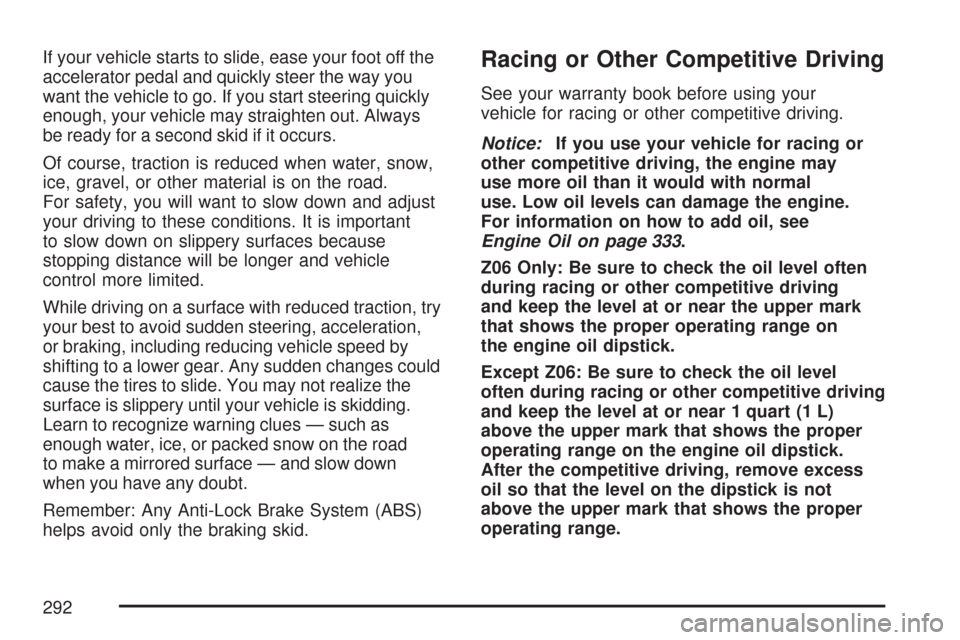
If your vehicle starts to slide, ease your foot off the
accelerator pedal and quickly steer the way you
want the vehicle to go. If you start steering quickly
enough, your vehicle may straighten out. Always
be ready for a second skid if it occurs.
Of course, traction is reduced when water, snow,
ice, gravel, or other material is on the road.
For safety, you will want to slow down and adjust
your driving to these conditions. It is important
to slow down on slippery surfaces because
stopping distance will be longer and vehicle
control more limited.
While driving on a surface with reduced traction, try
your best to avoid sudden steering, acceleration,
or braking, including reducing vehicle speed by
shifting to a lower gear. Any sudden changes could
cause the tires to slide. You may not realize the
surface is slippery until your vehicle is skidding.
Learn to recognize warning clues — such as
enough water, ice, or packed snow on the road
to make a mirrored surface — and slow down
when you have any doubt.
Remember: Any Anti-Lock Brake System (ABS)
helps avoid only the braking skid.Racing or Other Competitive Driving
See your warranty book before using your
vehicle for racing or other competitive driving.
Notice:If you use your vehicle for racing or
other competitive driving, the engine may
use more oil than it would with normal
use. Low oil levels can damage the engine.
For information on how to add oil, see
Engine Oil on page 333.
Z06 Only: Be sure to check the oil level often
during racing or other competitive driving
and keep the level at or near the upper mark
that shows the proper operating range on
the engine oil dipstick.
Except Z06: Be sure to check the oil level
often during racing or other competitive driving
and keep the level at or near 1 quart (1 L)
above the upper mark that shows the proper
operating range on the engine oil dipstick.
After the competitive driving, remove excess
oil so that the level on the dipstick is not
above the upper mark that shows the proper
operating range.
292
Page 306 of 488
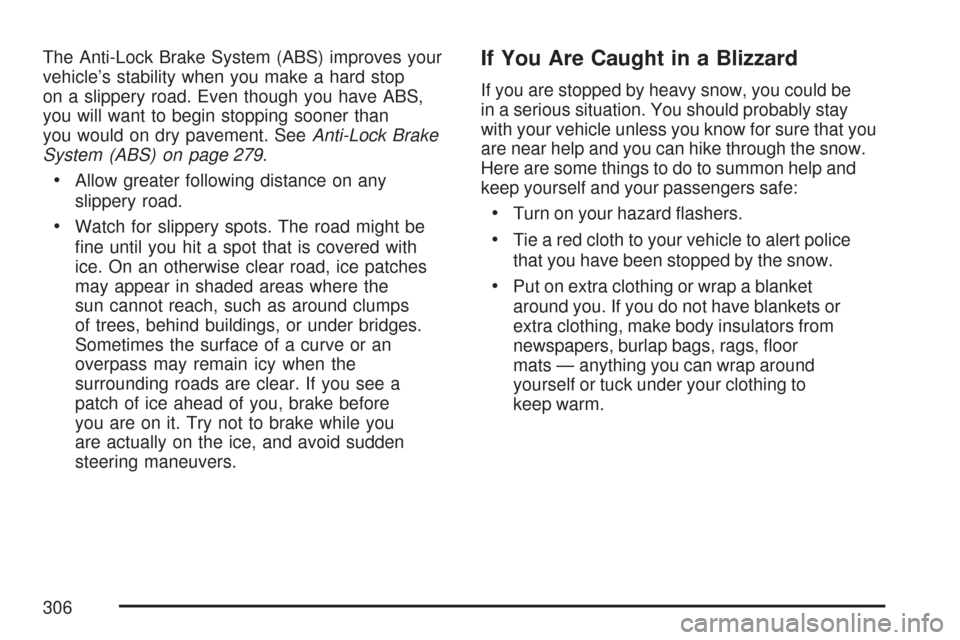
The Anti-Lock Brake System (ABS) improves your
vehicle’s stability when you make a hard stop
on a slippery road. Even though you have ABS,
you will want to begin stopping sooner than
you would on dry pavement. SeeAnti-Lock Brake
System (ABS) on page 279.
Allow greater following distance on any
slippery road.
Watch for slippery spots. The road might be
�ne until you hit a spot that is covered with
ice. On an otherwise clear road, ice patches
may appear in shaded areas where the
sun cannot reach, such as around clumps
of trees, behind buildings, or under bridges.
Sometimes the surface of a curve or an
overpass may remain icy when the
surrounding roads are clear. If you see a
patch of ice ahead of you, brake before
you are on it. Try not to brake while you
are actually on the ice, and avoid sudden
steering maneuvers.
If You Are Caught in a Blizzard
If you are stopped by heavy snow, you could be
in a serious situation. You should probably stay
with your vehicle unless you know for sure that you
are near help and you can hike through the snow.
Here are some things to do to summon help and
keep yourself and your passengers safe:
Turn on your hazard �ashers.
Tie a red cloth to your vehicle to alert police
that you have been stopped by the snow.
Put on extra clothing or wrap a blanket
around you. If you do not have blankets or
extra clothing, make body insulators from
newspapers, burlap bags, rags, �oor
mats — anything you can wrap around
yourself or tuck under your clothing to
keep warm.
306
Page 307 of 488

You can run the engine to keep warm, but
be careful.
{CAUTION:
Snow can trap exhaust gases under
your vehicle. This can cause deadly
CO (carbon monoxide) gas to get inside.
CO could overcome you and kill you.
You cannot see it or smell it, so you
might not know it is in your vehicle.
Clear away snow from around the base
of your vehicle, especially any that is
blocking the exhaust pipe. And check
around again from time to time to be
sure snow does not collect there.
Open a window just a little on the side of
the vehicle that is away from the wind.
This will help keep CO out.
Run your engine only as long as you must.
This saves fuel. When you run the engine, make it
go a little faster than just idle. That is, push the
accelerator slightly. This uses less fuel for the heat
that you get and it keeps the battery charged.
307
Page 318 of 488
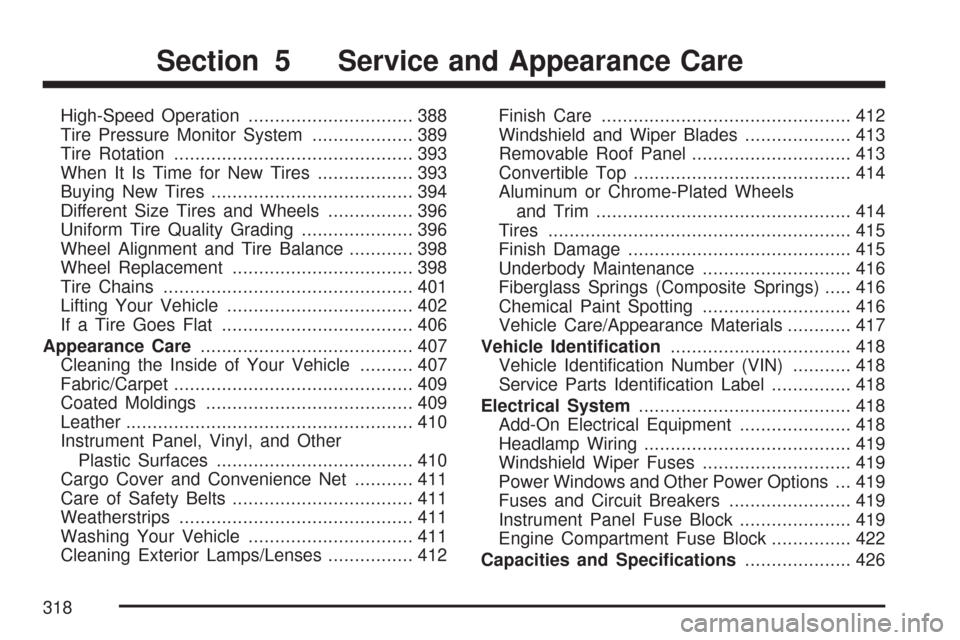
High-Speed Operation............................... 388
Tire Pressure Monitor System................... 389
Tire Rotation............................................. 393
When It Is Time for New Tires.................. 393
Buying New Tires...................................... 394
Different Size Tires and Wheels................ 396
Uniform Tire Quality Grading..................... 396
Wheel Alignment and Tire Balance............ 398
Wheel Replacement.................................. 398
Tire Chains............................................... 401
Lifting Your Vehicle................................... 402
If a Tire Goes Flat.................................... 406
Appearance Care........................................ 407
Cleaning the Inside of Your Vehicle.......... 407
Fabric/Carpet............................................. 409
Coated Moldings....................................... 409
Leather...................................................... 410
Instrument Panel, Vinyl, and Other
Plastic Surfaces..................................... 410
Cargo Cover and Convenience Net........... 411
Care of Safety Belts.................................. 411
Weatherstrips............................................ 411
Washing Your Vehicle............................... 411
Cleaning Exterior Lamps/Lenses................ 412Finish Care............................................... 412
Windshield and Wiper Blades.................... 413
Removable Roof Panel.............................. 413
Convertible Top......................................... 414
Aluminum or Chrome-Plated Wheels
and Trim................................................ 414
Tires......................................................... 415
Finish Damage.......................................... 415
Underbody Maintenance............................ 416
Fiberglass Springs (Composite Springs)..... 416
Chemical Paint Spotting............................ 416
Vehicle Care/Appearance Materials............ 417
Vehicle Identi�cation.................................. 418
Vehicle Identi�cation Number (VIN)........... 418
Service Parts Identi�cation Label............... 418
Electrical System........................................ 418
Add-On Electrical Equipment..................... 418
Headlamp Wiring....................................... 419
Windshield Wiper Fuses............................ 419
Power Windows and Other Power Options ... 419
Fuses and Circuit Breakers....................... 419
Instrument Panel Fuse Block..................... 419
Engine Compartment Fuse Block............... 422
Capacities and Speci�cations.................... 426
Section 5 Service and Appearance Care
318
Page 319 of 488

Service
Your dealer knows your vehicle best and
wants you to be happy with it. We hope you will
go to your dealer for all your service needs.
You will get genuine GM parts and GM-trained
and supported service people.
We hope you will want to keep your GM vehicle
all GM. Genuine GM parts have one of these
marks:
Accessories and Modi�cations
When you add non-GM accessories to your vehicle
they can affect your vehicle’s performance and
safety, including such things as, airbags, braking,
stability, ride and handling, emissions systems,
aerodynamics, durability, and electronic systems
like anti-lock brakes, traction control and
stability control. Some of these accessories may
even cause malfunction or damage not covered
by warranty.
GM Accessories are designed to complement
and function with other systems on your vehicle.
Your GM dealer/retailer can accessorize your
vehicle using genuine GM Accessories. When
you go to your GM dealer/retailer and ask for
GM Accessories, you will know that GM-trained
and supported service technicians will perform
the work using genuine GM Accessories.
319
Page 325 of 488
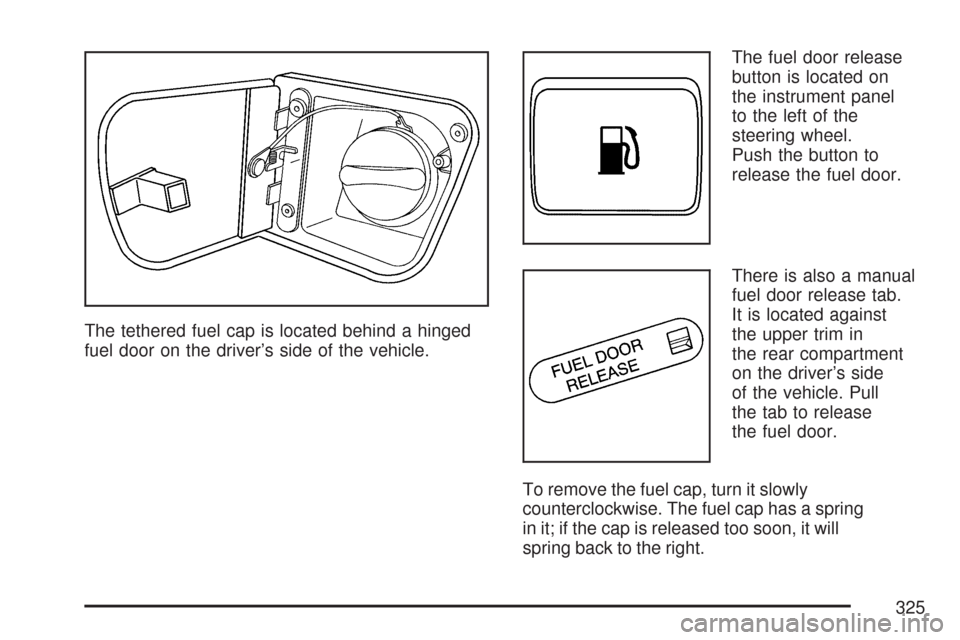
The tethered fuel cap is located behind a hinged
fuel door on the driver’s side of the vehicle.The fuel door release
button is located on
the instrument panel
to the left of the
steering wheel.
Push the button to
release the fuel door.
There is also a manual
fuel door release tab.
It is located against
the upper trim in
the rear compartment
on the driver’s side
of the vehicle. Pull
the tab to release
the fuel door.
To remove the fuel cap, turn it slowly
counterclockwise. The fuel cap has a spring
in it; if the cap is released too soon, it will
spring back to the right.
325
Page 326 of 488
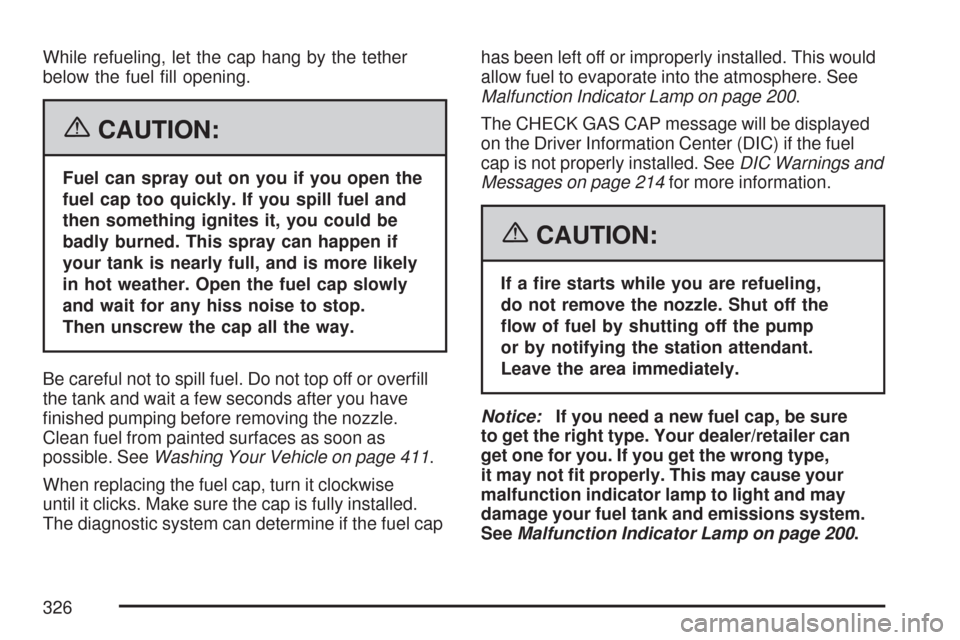
While refueling, let the cap hang by the tether
below the fuel �ll opening.
{CAUTION:
Fuel can spray out on you if you open the
fuel cap too quickly. If you spill fuel and
then something ignites it, you could be
badly burned. This spray can happen if
your tank is nearly full, and is more likely
in hot weather. Open the fuel cap slowly
and wait for any hiss noise to stop.
Then unscrew the cap all the way.
Be careful not to spill fuel. Do not top off or over�ll
the tank and wait a few seconds after you have
�nished pumping before removing the nozzle.
Clean fuel from painted surfaces as soon as
possible. SeeWashing Your Vehicle on page 411.
When replacing the fuel cap, turn it clockwise
until it clicks. Make sure the cap is fully installed.
The diagnostic system can determine if the fuel caphas been left off or improperly installed. This would
allow fuel to evaporate into the atmosphere. See
Malfunction Indicator Lamp on page 200.
The CHECK GAS CAP message will be displayed
on the Driver Information Center (DIC) if the fuel
cap is not properly installed. SeeDIC Warnings and
Messages on page 214for more information.
{CAUTION:
If a �re starts while you are refueling,
do not remove the nozzle. Shut off the
�ow of fuel by shutting off the pump
or by notifying the station attendant.
Leave the area immediately.
Notice:If you need a new fuel cap, be sure
to get the right type. Your dealer/retailer can
get one for you. If you get the wrong type,
it may not �t properly. This may cause your
malfunction indicator lamp to light and may
damage your fuel tank and emissions system.
SeeMalfunction Indicator Lamp on page 200.
326
Page 331 of 488
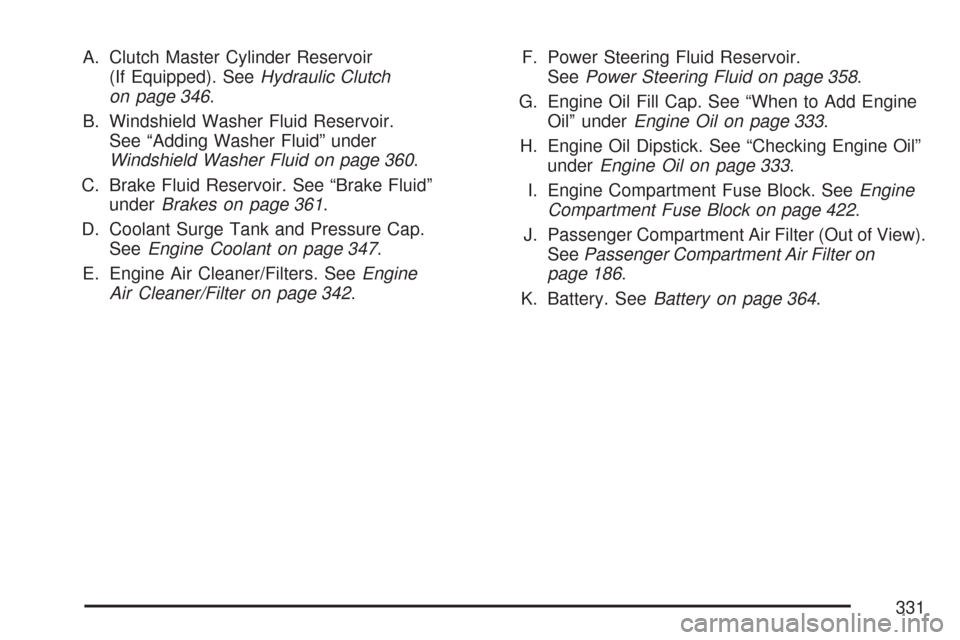
A. Clutch Master Cylinder Reservoir
(If Equipped). SeeHydraulic Clutch
on page 346.
B. Windshield Washer Fluid Reservoir.
See “Adding Washer Fluid” under
Windshield Washer Fluid on page 360.
C. Brake Fluid Reservoir. See “Brake Fluid”
underBrakes on page 361.
D. Coolant Surge Tank and Pressure Cap.
SeeEngine Coolant on page 347.
E. Engine Air Cleaner/Filters. SeeEngine
Air Cleaner/Filter on page 342.F. Power Steering Fluid Reservoir.
SeePower Steering Fluid on page 358.
G. Engine Oil Fill Cap. See “When to Add Engine
Oil” underEngine Oil on page 333.
H. Engine Oil Dipstick. See “Checking Engine Oil”
underEngine Oil on page 333.
I. Engine Compartment Fuse Block. SeeEngine
Compartment Fuse Block on page 422.
J. Passenger Compartment Air Filter (Out of View).
SeePassenger Compartment Air Filter on
page 186.
K. Battery. SeeBattery on page 364.
331